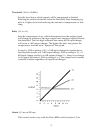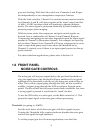
The speed with which a limiter responds to the input signal is also im-
portant. If the limiter tries to follow every little nuance of music, the
sound can be overly "choppy." Often, you'll want the limiter to affect
dynamic range over a somewhat longer period of time. The Release
control sets this time period.
Clamping a signal too rapidly can greatly reduce a transient, producing
a somewhat dull sound. The Attack control determines how long it
takes for the limiter's clamping action to begin.
These controls affect the limiter only when it is in Peak mode, where
all limiting is based on the value of signal peaks. In RMS mode, the
limiter automatically chooses appropriate attack and release times ac-
cording to the input signal dynamics.
Compression
Compression is similar to limiting, but rather than clamp all signals to
a constant threshold, the output changes at a lesser rate than the input.
For example, with a 4:1 compression ratio (as set with the ratio control),
a 4 dB input level change produces a 1 dB ouput level change; an 8 dB
input level change produces a 2 dB output level change.
The following figure shows the same signal that was limited earlier,
but this time the response has been set for compression. Note how the
dynamics of the entire signal are affected, not just those portions above
a certain threshold.
AMPLITUDE VS. TIME
18


















